#amarna era
Explore tagged Tumblr posts
Text

Bithiah, the Woman of Valor
#Art#My art#Bithiah#Batya#Egyptian art#Masr#Coptic art#Most of the jewelry here is based on real Coptic or other late antique Egyptian jewelry#The exception is the belt which is fantasy the ring which is more modern#And the ear plugs which are accurate to the Amarna era and a bit after that but didn't seem to stay past the Ptolemies
20 notes
·
View notes
Text
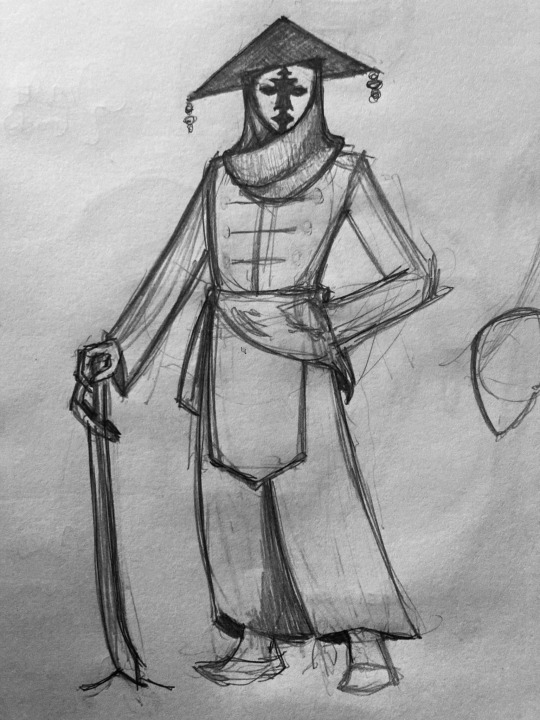
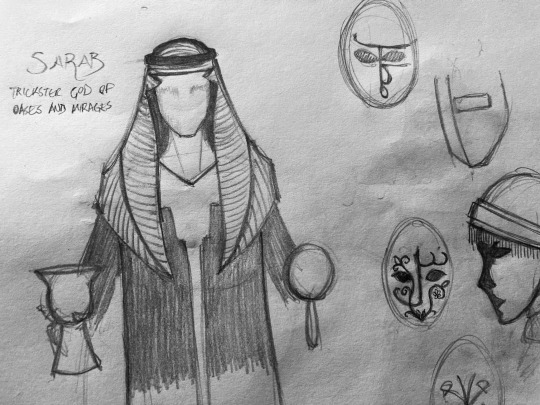
(I've started the worse habit of taking pictures of sketches and getting partway through explaining them and then forgetting it's still in Drafts)
The reason I was sketching fantasy camels a while back, by the way, was... okay, let me back up
In the NieR games there's a labyrinthine desert city called Façade, inhabited by the Masked People. Façade is governed under a long list of esoteric rules that outsiders find frustrating, but the Masked People are all pretty content with it, and there are indications that every rule originally had a really good reason it was created no matter how pointless it seems now.
This would just be a Neat Thing sitting in the back of my brain... if not for the fact that in Sunless Sea there's an island called Visage, inhabited by descendants from Amarna who now live by a complex system of esoteric social norms dictated by the kind of animal mask you wear.
To my knowledge there's no direct influence between them, which catches my imagination further. "Cities of masks and rules" is so distinct it feels like an otherworldly fantasy archetype, a trope that only caught on in another timeline the way elves and dwarves did in ours. (A friend pointed out it has a certain hint of orientalism - veiled courtiers whispering in desert palaces - though a rather abstract kind.) But exploring strange human cultures is part of what I like doing with Cosmodesy, and the seeds of my own version finally clicked into place.
The Mawlayani say that the city of Mazhar was founded centuries ago by their ancestors, former slaves lost in the desert on the verge of death who discovered a hidden oasis. They took this as a sign and settled there, giving their thanks to Sarab, a trickster god of secrets and illusions. Some centuries later, changes in trade turned Mazhar into a convenient stop for merchant caravans. The city has flourished to the limits of the aquifer below, and water supply has been carefully managed ever since overuse led to a nearly disastrous drought. To merchants, however, the problem is invisible, and it is counted as merely another of the Mawlayani's many eccentricities.
The statue in Sarab's temple is famously faceless, signifying the god's infinite appearances. The desert buries its blessings in the shifting sand, and the sun hides them among countless tricks of the light. For the same reason, the scarves worn to prevent sunstroke became the Mawlayani custom of concealing their faces in public at all times, which by the era of Mazhar's prosperity evolved into personalised masks. Traditional Mawlayani masks rarely resemble an actual face, with historical examples ranging from elaborate floral embroidery to minimalistic shapes framing the eyeholes. Symmetric calligraphy is a popular modern style.
I have no idea if Mazhar is in any of my existing worlds or if it's its own thing. Probably Takiwa if any of them.
#artists on tumblr#my art#fantasy art#character art#concept art#pencil sketch#cosmodesy#panhumanity#worldbuilding#thinking out loud
10 notes
·
View notes
Text



Two Princesses - Met Museum Collection
Inventory Number: 1985.328.6 New Kingdom, Amarna Period, ca. 1353–1336 B.C. Dynasty 18, Reign of Akhenaton. Location Information: Middle Egypt, Hermopolis (Ashmunein; Khemenu), Pylon of Ramesses II, Foundations, Deutsche Hermopolis Expedition 1939; Probably originally from Amarna (Akhetaten)
Description:
The demonstration of affection in this detail showing two of Akhenaten's daughters is typical of the intimacy allowed in representations of the royal family during the Amarna period. Although affectionate gestures are not entirely unknown in royal art of other eras, the casual pose and the fully frontal depiction of the older sister's torso are unparalleled among royal figures and are extremely rare in any type of representation during other periods of Egyptian art.
#two princesses#met museum#new kingdom#new kingdom ap#general childrens#1985.328.6#middle egypt#hermopolis#ashmunein#khemenu#amarna#akhetaten#girls hair and wigs#NKAPGHW#NKAPGC#upper egypt
2 notes
·
View notes
Text
Babylonian (Or, what's left...)
A sculpture depicting the culture of Babylon:

According to research I have obtained from local citizens and papers, it would appear that the Babylon I step through now is not the first attempt to form a successful empire. Before Babylon would ever stand on its own, it would be a part of the Akkadian Empire and would eventually develop into an important city in ancient Mesopotamia (The Monumental Fall of Babylon). Once Babylon transformed from a city into the First Babylonian Empire, while in the hands of Hammurabi, expanded his empire to greater heights, conquering a variety of city-states. Hammurabi effectively obtained control of the entirety of Mesopotamia, but ultimately, his predecessors failed to capitalize on his contributions to the empire (The Monumental Fall of Babylon). When The First Babylonian Empire collapsed, it fell under the control of foreign powers such as the Hittites and Assyrians, the latter with which they had competed with before.
Now, completely taken over by the Kassites, this era is synonymous with the period of Babylonian history known as “Middle Babylonian”. Unfortunately, this is also to be referred to as a time that represents decline within the kingdom. The nation as a whole was completely eclipsed by its neighbors (Livius). The decline would last for nearly a millennium, damaging any potential progress the nation could have had. This would continue to be an issue even after the Kassites are replaced as leaders, as Babylon has still failed to form a centralized government for its states.
Despite the lack of political power that can be seen during this period, there was some development regarding culture and the arts. The Amarna Letters revealed Kassites status as a member of a royal grouping of civilizations. Being a part of this royal grouping, they were able to obtain expensive and rare materials that could be utilized to make all kinds of unique sculptures and figurines (Knott).
4 notes
·
View notes
Photo

Las mujeres y la descendencia de Ramsés II
El harem estaba formado por las esposas principales y secundarias, los hijos y las nodrizas, así como sirvientes eran círculos cercanos al monarca y se sabe de algunos cercanos a los palacios en Menfis, Tebas, Amarna, entre otros. Estaban a cargo de la Gran Esposa Real.
Poseían tierras de cultivo, ganado, talleres y personal que trabajara en ellos, también escribas, funcionarios para la administración y servicio de las mujeres.
Ramsés II ascendió al trono en 1279 a.C., siendo uno de los faraones más longevos con un reinado de 66 años y vivió unos 90 años, con una descendencia de unos cien hijos e hijas y varias esposas. Se calcula aproximadamente de 48-50 varones y 40-53 mujeres.
Su primogénito y heredero era Amenherkhopshef quien murió en el 20° año de su reinado, le siguió Prehiwenemef, después Kharmuaset. Pero al morir Ramsés en 1212 a.e.c, fue sucedido por Merneptah.
Tuvo muchas mujeres, siendo mencionada por las fuentes ocho esposas principales, una de ellas, era Nefertari, que se casó desde muy joven con Ramsés II, y es representada junto al monarca en los templos de Abu Simbel y también tiene su tumba en el Valle de las Reinas, con la decoración más hermosa que ha llegado hasta nuestros días. Otra esposa que figura en el templo mayor de Abu Simbel, a través de la estela de matrimonio, donde relata la unión con la hija del rey hitita Hatusili III como parte de una negociación de un tratado de paz, luego del enfrentamiento de Kadesh.
Aunque también figuran como Esposas Reales sus propias hijas como lo fueron Meritamón y Nebetauy que tuvo con Nefertari, y Bintanat, hija de él y Isetnofret.
2 notes
·
View notes
Text
A common interpretation of Russian foreign policy ambitions holds that Russia strives for recognition as a great power—derzhavnost, as the University of Toronto’s Seva Gunitsky explains the term:
"A word that’s difficult to render into English precisely, derzhavnost essentially means both being a great power and being recognized as such by others. In Russia’s immediate neighborhood, this means an unquestioned sphere of influence, similar to America’s Monroe Doctrine. In dealing with other powerful states like the U.S., it implies respect, prestige, and peer recognition rolled into one—in other words, a seat at the table managing global affairs."
But here’s a puzzle: Russia has been seeking derzhavnost for centuries. It makes sense that Russia’s national ego would be bruised during the chaos of the Nineties, when the United States disregarded Russia as it made policy; it similarly makes sense that Russia would feel slighted in, say, the aftermath of its defeat in the Russo-Japanese war. Yet Russian foreign policymakers also felt slighted when Moscow (or St Petersburg’s) power was in the ascendant—when by any reasonable definition Russia was a leading state, like during era after the Napoleonic Wars or even during the early Cold War.
What’s key, as the Norwegian scholar Iver Neumann wrote back in 2008, is that Russia never felt itself to be accepted as a great power. Great-power status requires more than maxing certain metrics or being on the winning sides of wars—it requires a political system that meets the norms established by the gatekeepers of international society. Today, for instance, that means living up to the generic liberal aspirations of broadly “Western” society in human rights and democracy; two hundred years ago, it meant living up to (down to?) other Western values, like restricting women from taking part in government. More broadly, as Neumann discusses, European and Western powers have been suspicious of Russia for failing to develop liberal institutions and independent (but disciplining) societal groups that would enable Russia to create a compatible, “modern” society.
...
The drive for status and recognition is a fundamental part of international society, all the way back to the time of the Amarna tablets in ancient Egypt. One wonders whether all of this could have been avoided if, perhaps, the West could have just played more to derzhavnost—but it is also the case that, intermittently at least, the West did make overtures along these lines (remember the G-8?). Just because a drive for recognition is frustrated doesn’t mean that it could have been satisfied.
2 notes
·
View notes
Text

An image, sadly damaged, of Meketaten from her tomb at Amarna. She was the second of six daughters born to Akhenaten and Nefertiti.
Source
#meketaten#amarna period#ancient egypt#18th dynasty#amarna princess#amarna era#nefertiti#akhenaten#long live the queue
14 notes
·
View notes
Text
The Voiceless Diplomats
For centuries, diplomacy has been the cornerstone of civilization’s survival. It’s a sophisticated dance between nations to prevent conflicts and secure peace, both an art and a science. Yet, in a time of global tensions and the looming specter of nuclear annihilation, the United States finds itself neglecting one of its most important tools: dialogue with Russia.
What’s the historical significance of diplomacy, ambassadors, and embassies? And what does it matter if Tucker Carlson has to fly to Moscow himself (again!) to keep the peace? This time, he spoke to Sergei Lavrov, the Russian Foreign Minister and a titan of diplomacy. The interview will air on X tomorrow night.
Then, we’ll delve into why the State Department’s current approach risks catastrophe in an era when miscommunication — or no communication at all — could spell global annihilation.
The Origins of Diplomacy
The practice of diplomacy dates back thousands of years. Ancient civilizations, from Mesopotamia and Egypt to China and India, engaged in early forms of diplomacy, exchanging envoys to negotiate peace, trade agreements, and alliances.
The Amarna letters, a treasure trove of diplomatic correspondence between Egyptian pharaohs and neighboring rulers from the 14th century B.C., are some of the earliest records of formalized statecraft.
Diplomacy as we know it began to take shape during the Renaissance. Italian city-states like Venice and Florence established permanent embassies manned by resident ambassadors to foster relations with neighbors and rivals. By the 17th century, the Treaty of Westphalia (1648) had codified many principles of modern diplomacy, including sovereignty.
The 20th century saw the birth of multilateral diplomacy, with the United Nations and other forums serving as international platforms for dialogue. Complaints could be lodged, and nations could negotiate agreements without going to war. The Cold War might have been a lousy time for international relations, but at least it was accompanied by expanding forums for global dialogue.
1 note
·
View note
Text
Explore the Ancient Wonders: A Trip to Tel El Amarna and Beni Hassan from Cairo

If you're an avid traveler or history enthusiast, Egypt offers an endless array of fascinating destinations. Among the less-explored yet incredibly rich archaeological sites, the Trip to Tel El Amarna and Beni Hassan from Cairo stands out as an unforgettable experience. Located just a few hours away from the hustle and bustle of Cairo, these ancient sites offer a glimpse into Egypt’s fascinating history, far beyond the typical tourist attractions.
Discover Tel El Amarna: The City of Akhenaten
The journey begins with a visit to Tel El Amarna, the capital established by Pharaoh Akhenaten in the 14th century BC. Often referred to as the "city of the sun," it was created as a spiritual center dedicated to the worship of the sun god Aten. The ruins here are remarkably well-preserved, providing an authentic view of life during Akhenaten’s reign. Visitors can walk through the remnants of temples, palaces, and even the royal tombs, each telling a story of an era long past.
Akhenaten’s radical shift in religious beliefs—shifting Egypt's traditional polytheistic system to monotheism, centered around the sun god—makes Tel El Amarna an essential stop for anyone interested in the cultural and religious transformations of ancient Egypt.
Beni Hassan: Ancient Rock Tombs and Intricate Wall Art
From Tel El Amarna, the tour continues to Beni Hassan, a collection of tombs carved into the limestone cliffs along the Nile. These tombs, dating back to the Middle Kingdom, are some of the most beautifully decorated tombs in Egypt. Beni Hassan offers a rare insight into the lives of Egypt's elite, with their intricate wall art depicting scenes of daily life, warfare, and hunting.
Unlike other tombs in Egypt, the paintings here remain vibrant, offering a rare and vivid portrayal of ancient Egyptian society. The craftsmanship of the tombs at Beni Hassan reflects the high status of the individuals buried there, as well as the artistic achievements of the Middle Kingdom.
Why You Should Take This Tour from Cairo
1. Unique Historical Sites While most travelers focus on the major sites in Cairo like the Pyramids of Giza and the Egyptian Museum, a visit to Tel El Amarna and Beni Hassan from Cairo offers something truly unique. The relatively low foot traffic at these sites ensures a more intimate and peaceful experience.
2. Immersive Experience The combination of visiting a royal city and exploring ancient tombs gives you a well-rounded experience of Egypt’s history. You’ll get a deeper understanding of both the religious and societal shifts that occurred over the centuries.
3. Accessible from Cairo Located just a short drive away, this day trip offers a chance to escape the crowded streets of Cairo and explore some of Egypt’s most captivating historical treasures without venturing too far from the city.
Plan Your Trip Today!
If you’re ready to immerse yourself in the wonders of ancient Egypt, consider booking a Trip to Tel El Amarna and Beni Hassan from Cairo. This day tour promises to be a highlight of your Egyptian adventure, offering a rare and intimate look at some of Egypt's most historic and lesser-known sites.
Whether you’re a history buff, an archaeology enthusiast, or simply someone who appreciates the beauty of ancient culture, this tour is a must-do!
Book your trip now with Egypt Tours and embark on a journey through time to explore Egypt’s hidden gems.
0 notes
Photo
thatblckgrl:
The Ankh was, for the ancient Egyptians, the symbol (the actual Hieroglyphic sign) of life but it is an enduring icon that remains with us even today as a Christian cross. It is one of the most potent symbols represented in Egyptian art, often forming a part of decorative motifs.
The ankh seems at least to be an evolved form of, or associated with the Egyptian glyph for magical protection, sa. However, what the sign itself represents is often disputed. For example, Sir Alan Gardiner thought that it showed a sandal strap with the loop at the top forming the strap, but if so, the symbolism is obscure and so his theory has found little real favor early on. However, this interpretation seems to have received some acceptance among modern writers. It would seem that the ancient Egyptians called that part of the sandal ‘nkh (exact pronunciation unknown). Because this word was composed of the same consonants as the word “life”, the sign to represent that particular part of the sandal, was also used to write the word “life”.
Another theory holds that the ankh was symbolic of the sunrise, with the loop representing the Sun rising above the horizon, which is represented by the crossbar. The vertical section below the crossbar would then be the path of the sun.
Wolfhart Westendorf felt it was associated with the tyet emblem, or the “knot of Isis”. He thought both were ties for ceremonial girdles. Winfried Barta connected the ankh with the royal cartouche in which the king’s name was written, while others have even identified it as a penis sheath. The presence of a design resembling a pubic triangle on one ankh of the New kingdom seems to allow for the idea that the sign may be a specifically sexual symbol. In fact, guides in Egypt today like to tell tourists that the circle at the top represents the female sexual organ, while the stump at the bottom the male organ and the crossed line, the children of the union. However, while this interpretation may have a long tradition, there is no scholarly research that would suggest such an exact meaning.
The ankh, on some temple walls in Upper Egypt, could also symbolize water in rituals of purification. Here, the king would stand between two gods, one of whom was usually Thoth, as they poured over him a stream of libations represented by ankhs.
The ancient gods of Egypt are often depicted as carrying ankh signs. We find Anqet, Ptah, Satet, Sobek, Tefnut, Osiris, Ra, Isis, Hathor, Anibus and many other gods often holding the ankh sign, along with a scepter, and in various tomb and temple reliefs, placing it in front of the king’s face to symbolize the breath of eternal life. During the Amarna period, the ankh sign was depicted being offered to Akhenaten and Nefertiti by the hands at the end of the rays descending from the sun disk, Aten. Therefore, the ankh sign is not only a symbol of worldly life, but of life in the netherworld. Therefore, we also find the dead being referred to as ankhu, and a term for a sarcophagus was neb-ankh, meaning possessor of life.
It is at least interesting that the ankh word was used for mirrors from at least the Middle Kingdom onward, and that indeed, many mirrors were shaped in the form of an ankh sign. Life and death mirror each other, and in any number of ancient religions, mirrors were used for purposes of divination.
In fact, the ankh sign in ancient Egypt seems to have transcended illiteracy, being comprehensible to even those who could not read. Hence, we even find it as a craftsman’s mark on pottery vessels.
As the Christian era eclipsed Egypt’s pharaonic pagan religion, the sign was adapted by the Coptic church as their unique form of a cross, known as the crux ansata.

557 notes
·
View notes
Text
Nefertiti, the last Pharaoh to be covered, has the greatest relative success yet:
In many ways of the women who ruled as well as reigned in Ancient Egypt Nerfertiti had some of the greatest success, due to both the great power of the Amarna-era Pharaonic system and its iconoclastic approach to the other elements that stifled the power in various points of her predecessors....and due to her husband openly admitting that she was three fingers of his left hand and all of his right. Unfortunately the price she and Akhenaten paid for iconoclasm was that they became archetypal heretics and arguably the ur-examples of the first true clash of state and religion, and reminders that in the short term the state always wins, but the short term neglected that the priests, as writers of histories, had the power over the long term.
0 notes
Text
Gli Shardana, il temibile popolo guerriero
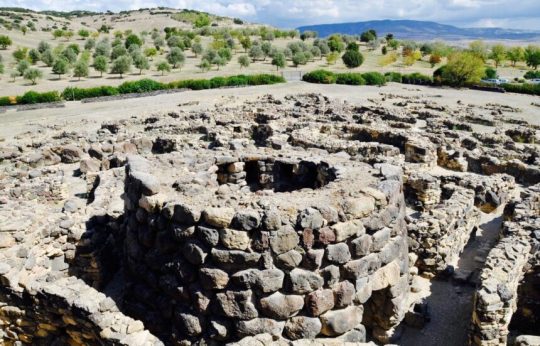
Durante l’età del bronzo, circa 1600 anni prima di Cristo, una moltitudine di popoli imperversò nelle acque del mar mediterraneo, e tra questi i più feroci e temuti furono gli Shardana. Ma chi erano questi antichi navigatori del mare? E qual è la loro origine? Oriente o Occidente? Gli Shardana (o Sherdana) hanno una provenienza incerta: c’è chi ipotizza che provenissero dalla Siria o dall’Anatolia (l’antica Turchia) e c’è chi invece pensa che corrispondano agli antichi sardi dell’età nuragica, o che si sovrapponessero ad essi, dando il nome all’isola, ma forse non lo sapremo mai con certezza. Sicuramente facevano parte di quei gruppi di navigatori che solcavano il Mediterraneo in lungo e in largo, in cerca di insediamenti in cui creare nuove colonie o di comunità con cui intrattenere rapporti commerciali o con cui scontrarsi per poterli depredare. Raggiunsero infatti la loro massima espansione durante l’età del Bronzo Recente (tra il 1300 ed il 900 a.C.), quando la loro influenza si allargò non solo all’Asia minore e alla Sardegna, ma anche alla Corsica e alle isole Baleari, e a vaste zone costiere dell’Africa settentrionale, della Spagna, dell’Italia centrale, della Sicilia e della Puglia. Tutti i territori occupati diventavano poi basi da cui intraprendere nuove spedizioni di conquista. Era una popolazione che basava la propria economia sull’agricoltura e sull’allevamento, ma il loro punto di forza fu la navigazione e la lavorazione del bronzo: sono infatti famosi i loro “bronzetti nuragici” raffiguranti guerrieri e navi. Mamma mia arrivano gli Shardana I primi a citarli furono gli antichi egizi, nelle tavolette di Amarna, datate 1350 a.C. circa, in cui erano definiti pirati, e chiamati col nome Sherdana. Infatti l’Egitto subì varie ondate di attacchi e incursioni, culminate negli scontri avvenuti durante il regno del faraone Ramses II, intorno al 1278 a.C. nelle zone del delta del Nilo. Il maggior terrore agli occhi degli egiziani era costituito dalle grosse navi da guerra a disposizione degli Shardana, che avevano massicci mezzi capaci di solcare le acque marine, mentre le imbarcazioni egizie erano di tipo fluviale, adatte cioè alle acque basse e tranquille del Nilo, non certo alle onde alte del Mediterraneo. Questo era un motivo per cui riuscivano a vincere facilmente le battaglie navali. Inoltre erano militari finemente addestrati, pronti a scendere in campo armati di tutto punto: grossi elmi cornuti, grandi scudi rotondi e lunghe spade, forti della loro tecnica di lavorazione del rame e di altre leghe metalliche, che dava maggiore potenza alla loro natura di razziatori. Ma in una di queste incursioni però, Ramses II fu capace di non farsi cogliere impreparato, riuscì a sconfiggerli, e addirittura a catturarne qualche centinaio, e avendone colto la loro audacia e forza in battaglia, decise di arruolarli nella guardia reale. I guerrieri Shardana divennero quindi anche dei mercenari, e per molto tempo non solo rimasero le guardie personali dei faraoni, ma furono impiegati anche in guerra. Tra quelle a cui parteciparono, è interessante ricordare la battaglia di Qadesh, una delle più importanti dell’era antica, combattuta tra gli egiziani e l’impero ittita sulle sponde del fiume Oronte in Siria, nel 1274 a.C., in cui il contingente di 520 Shardana si distinse per essere l’unica fanteria pesante presente nell’esercito. È giusto sottolineare che le fonti egiziane parlano di vittoria egiziana, mentre le fonti ittite parlano di vittoria ittita, quindi in realtà chi ebbe la meglio non si sa (probabilmente nessuna delle due parti), tanto che fu siglato un trattato di pace tra le due nazioni, il primo a noi conosciuto, per porre fine alla serie di guerre che da lungo tempo si protraevano tra i due popoli. Ma poi, che fine hanno fatto? Fonti storiche rivelano che probabilmente un grosso tsunami o comunque diverse inondazioni travolsero gran parte della Sardegna, distruggendo così il loro territorio e i loro villaggi, che li costrinse ad abbandonare l’isola e i suoi insediamenti. Le comunità che si erano insediate in altri luoghi, o come mercenari in Egitto, si pensa che col tempo si mescolarono con le società con cui erano entrati in contatto, integrandosi nella loro cultura e perdendo pian piano la propria identità di popolo. Ma tante domande restano ancora senza risposte, su questa gloriosa stirpe che ha solcato il Mediterraneo, e di cui, forse, non sapremo mai la vera origine. Nel frattempo, il dibattito resta aperto. Read the full article
1 note
·
View note
Text
Excellent pictures taken at the Neues Museum of Berlin by a young man on YouTube called The King's Monologue. It's a Livestream called The Neues Museum of Berlin BLEW MY MIND (Pts 1 and 2). He makes very scrupulous observations that many brush over or block out. At the bottom of this compilation is his trip to the Louvre Museum in Paris reveal some shocking rarities.
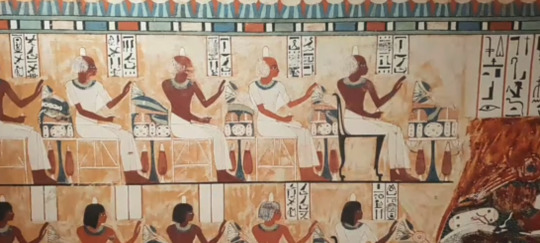
color variation in males from User, Elephantine, dynasty 18.
Whole scene
https://www.archaeology.wiki/wp-content/uploads/2014/03/elephantine-tomb.jpg

.

.
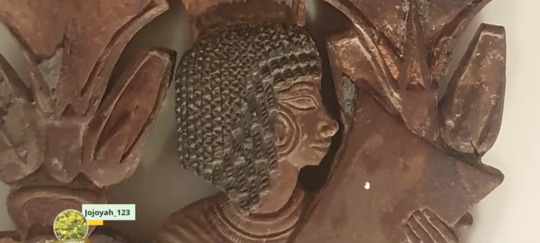
.
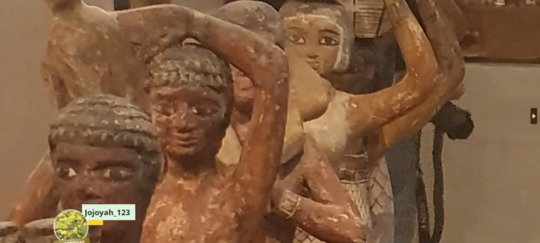
.
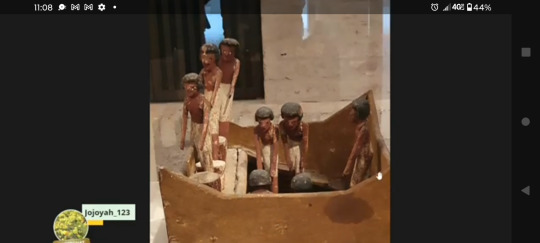
.

Early dynastic period
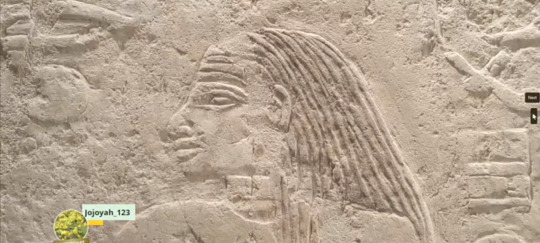
Early era
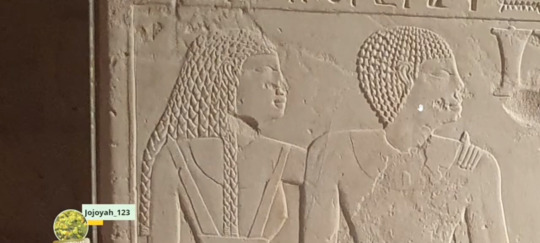
.


Roman era

. woman just as dark reddish brown as the man

A lady from Antigua informed him that the style is called sisterlocks in modern times. These hairstyles were worn in West and Central Africa as well. See Diop's statement in the link about traditional hair of women in Senegal before the 1930s, both natural and wig (only seen in non Islamic areas after that time)...
1
https://www.tumblr.com/shwat2013/680165437249585152/whether-wig-or-not-i-think-people-sometimes?source=share. .
2
Wolof girl Senegal 1800s
a
https://64.media.tumblr.com/a236b85b80a40ea0690388ff73d5decc/c0bc9aed5175f391-df/s640x960/2ec47a43c894be96d47a61bc4ca79f771a80e1c4.jpg .
b
https://commons.wikimedia.org/wiki/File:Senegal-thioup-bazin.jpg#mw-jump-to-license
3
Just like ancient Egypt, the same wig form is traditionally worn in Nambia, Congo, Angola (of old), East Africa etc. Also worn naturally
link
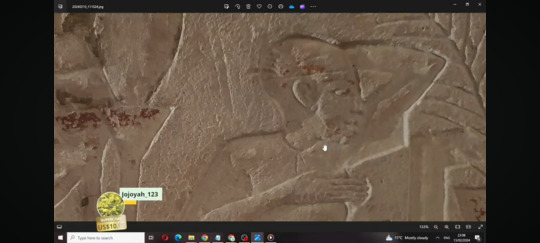
.

. Sahure 5th dynastic period
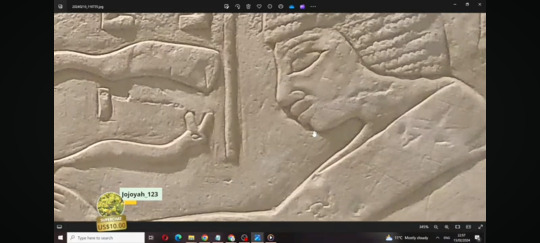
Early period

Early period
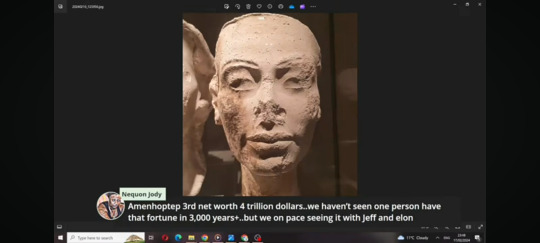

Have to point out that these are actual faces of Akhenaten and Nefertari because it's taken from a cast mold. THIS MEANS YOU'RE LOOKING AT THEM. See museum link below picture for more on this technique of sculptor Thutmose. As we see the museum label once informed us that it's one of the plaster molds, but now just says portrait heads. The following picture is not from the YouTuber

The following description is from the Egyptian Museum in Berlin, about one plaster cast mask (Inv.-No. ÄM 21356), but it really speaks on the technique of all portraits like it of the era. Most are from the ancient artist Thutmose of the Achet-Aton (today called Amarna), in Middle Egypt, which was the capital of Egypt during the reign of Akhenaten and Nefertiti. It reads… This portrait study gives a unique view of the work technique of the artist; first a form was taken directly from the subject"s face and a gypsum copy was made from the mould. The copy was then finished by the sculptor in various details, especially the eyes since these had to be closed when the mask was taken from the face. In these rare instances we are directly confronted with 'real' people even if we do not know their names or anything else about them.
Scroll to Mask from Amarna Portrait of a Man.
http://www.egyptian-museum-berlin.com/c52.php
To see more actual faces from cast molds (rare), scroll down to "A few more every day Egyptians of the Amarna period", near bottom of the compilation in this link
https://www.tumblr.com/shwat2013/677380292714037248/amenhotep-iii-at-the-new-york-metropolitan-museum?source=share
picture with old museum label
https://www.reddit.com/media?url=https%3A%2F%2Fi.redd.it%2F3q2tykijo0da1.jpg.

In mythology, Memnon was a king of Aethiopia (Sudan in this case) and son of Tithonus and Eos. As a warrior he was considered to be almost Achilles' equal in skill. During the Trojan War, Here, he is compared to Akhenaten
Princess
link
18th dynasty man from Louvre

link

.Akhenaton on the left and a Nubian at the Flinders Petrie Museum of archeology, London, England on the right
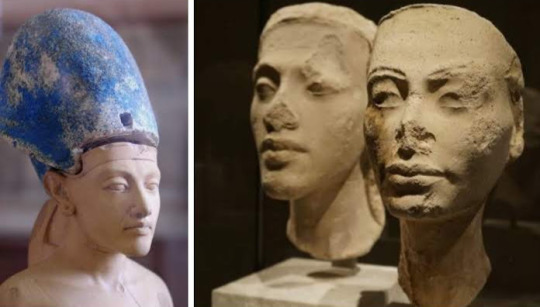
This is a more of a stylized "artist conception on the left". We can see on the actual face from the sculptor studio on the right, he really didn't have a straight pointed nose...but rather more rounded, wide and flat. Strangely, I can see the faint character of the real person in the stylized conventional portraits
..

. Tiye
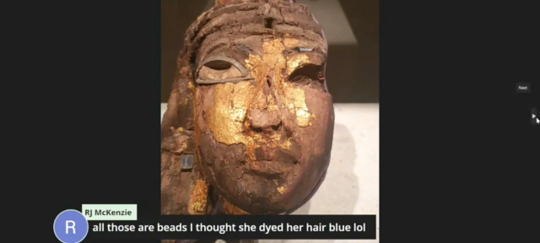
.Tiye or a relative
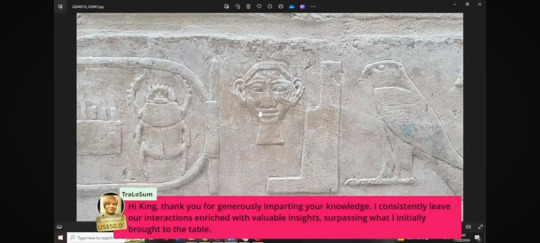
.

. hieroglyph for face
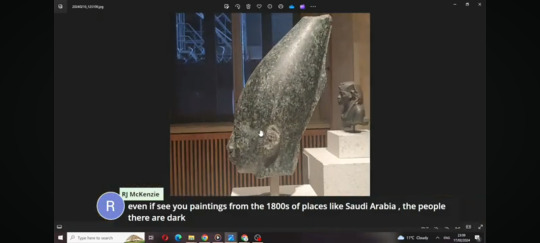
. Amenenehat III
.
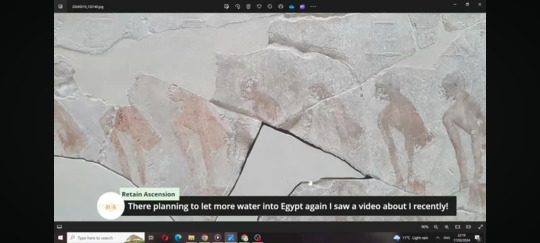
.
More from the YouTuber. This time at the Louvre Museum (2 parts)
Part 1
Ink
Part 2
link
Clean, clear and unadulterated images from the video "MOST BEAUTIFUL NON-ROYAL TOMBS! WESTERN THEBES (LUXOR) EGYPT", as she walks through... These are wonderful and unbias. There's no way you can see these and not at least ask yourself... are these the people of the Aswan Elephantine area who lean more "black" in appearance
Video link
Be sure to stop at the bottom where it says "More from @afcnamrcn23". Don't be distracted by the pictures and links under that. They will occur again so that you can continue with the main post in sequence.
0 notes
Text
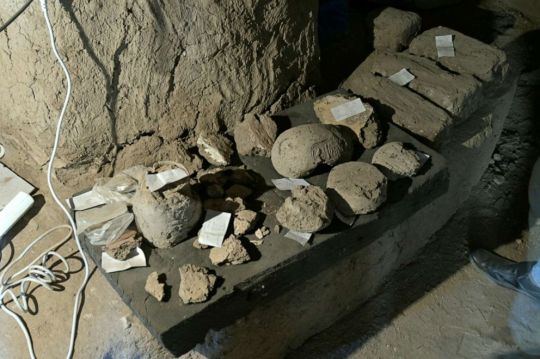
Archeological discoveries are seen in Luxor, Egypt, in this undated handout photo.
Zahi Hawass Center For Egyptology via Reuters
A mission led by Egypt's former antiquities chief Zahi Hawass unearthed "several areas or neighborhoods" of the 3,000-year-old city after seven months of excavation.
MORE: 'Pharaoh's curse' blamed for Suez Canal blockage, other unfortunate events in Egypt
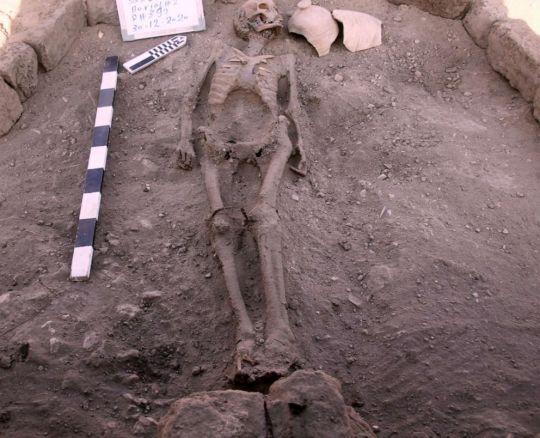
Skeletal human remains sit in the archeological dig site in Luxor, Egypt, in this undated handout photo.
Zahi Hawass Center For Egyptology via Reuters
The city, which Hawass also called "The Rise of Aten," dates back to the era of 18th-dynasty king Amenhotep III, who ruled Egypt from 1391 till 1353 B.C.
"The excavation started in September 2020 and within weeks, to the team's great surprise, formations of mud bricks began to appear in all directions," Egypt's antiquities ministry said in a statement.
"What they unearthed was the site of a large city in a good condition of preservation, with almost complete walls, and with rooms filled with tools of daily life."
The southern part of the city includes a bakery, ovens and storage pottery while the northern part, most of which remain under the sands, comprises administrative and residential districts, the ministry added.
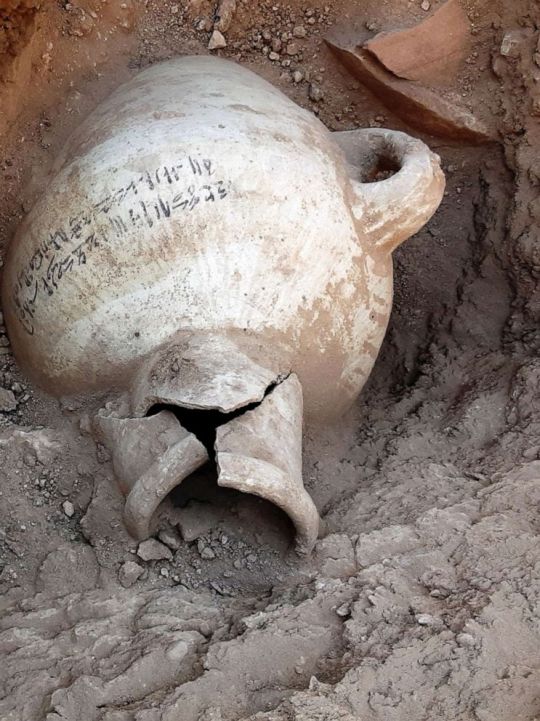
Archeological discoveries sit among the dig in Luxor, Egypt, in this undated handout photo.
Zahi Hawass Center For Egyptology via Reuters
"The city's streets are flanked by houses," with some walls up to 3 meter high, Hawass also said.
Hawass said the city was still active during Amenhotep III's co-regency with his son, Akhenaten, but that the latter eventually abandoned it when he took the throne. Akhenaten then founded Amarna, a new capital in the modern-day province of Minya, some 250 km south of Cairo and 400 km north of Luxor.
MORE: Egypt unlocks more secrets in Saqqara with discovery of temple, sarcophagi
Betsy Brian, professor of egyptology at Johns Hopkins University in Baltimore, said the finding's importance is only second to the earth-shattering discovery of King Tut's tomb.

A new archaeological discovery stands in Luxor, Egypt, in this undated handout photo.
Zahi Hawass Center For Egyptology via Reuters
Egypt has made a string of major discoveries over the past few years as it hopes to revive its vital tourism industry, which was badly hit by two uprisings and the COVID-19 pandemic.
The country held a glitzy parade to move 22 mummies to a newly inaugurated museum in Cairo on Saturday and is preparing to open the Grand Egyptian Museum near the Giza Pyramids later this year.
Egypt says GEM will be the biggest museum in the world dedicated to a single civilization.
1 note
·
View note
Text
😳🍁 MUCHOS CREEN QUE EL ARAMEO FUE EL LENGUAJE DE CRISTO ¿Pero realmente sabes quienes fueron los Arameos? Aquí te lo cuento
Los arameos, una antigua etnia semita, emergieron en la Edad del Bronce y jugaron un papel crucial en la historia del Cercano Oriente. Originarios de lo que ahora es Siria, su influencia y lenguaje se extendieron por Mesopotamia, Palestina y más allá, incluso hasta el golfo Pérsico y Egipto.
Durante el segundo milenio a.C., distintos grupos arameos migraron y se establecieron en una serie de reinos y ciudades-estado. Entre ellos, destacaron Aram-Damasco y Bit-Adini. Estos estados a menudo se entremezclaron y se enfrentaron con las grandes potencias de la época, como los asirios y los babilonios. A pesar de las tensiones, el comercio floreció entre estos pueblos, y con él, la difusión del arameo como lingua franca de la región.
El arameo, con su distintivo alfabeto, fue adoptado oficialmente en muchas áreas, incluyendo el vasto Imperio Neoasirio. Este idioma también dejó su marca en las inscripciones reales y en la correspondencia diplomática, como se evidencia en las cartas de Amarna, que subrayan su uso como idioma diplomático en el siglo XIV a.C.
La caída del Imperio Neoasirio en el siglo VII a.C. no disminuyó la importancia de los arameos. Al contrario, bajo el dominio persa aqueménida, el arameo se consolidó como idioma administrativo, evidencia de su influencia persistente.
La era helenística presenció un cambio gradual, con el griego comenzando a suplantar al arameo en algunos ámbitos. Sin embargo, el arameo no desapareció, persistiendo en comunidades judías y cristianas. Es más, el Talmud babilónico y los textos encontrados en Qumrán, como los famosos Rollos del Mar Muerto, contienen secciones significativas en arameo.
El cristianismo temprano, particularmente en Siria y Mesopotamia, fue moldeado por escritos arameos, y algunas de las primeras literaturas cristianas fueron compuestas en este idioma. Incluso se cree que Jesús de Nazaret habló en arameo, como reflejan algunas expresiones preservadas en el Nuevo Testamento.
Con el surgimiento y expansión del Islam en el siglo VII, el árabe comenzó a dominar, pero las comunidades arameas mantuvieron su lengua y cultura, a pesar de las dificultades. En la actualidad, las comunidades asirias y caldeas, descendientes de los arameos, continúan preservando su herencia lingüística y cultural, aunque enfrentan desafíos significativos.
A lo largo de los siglos, los arameos y su lengua han demostrado una notable resistencia, adaptándose a los cambios de poder y persistiendo en la memoria colectiva de la región. Su legado perdura en la lengua, la religión y la cultura, un testimonio del impacto duradero de este notable grupo étnico en la historia del mundo antiguo.
#arameo #historia #curiosidades #historias #leyendas #misterios #unangelporelmundo

1 note
·
View note
Text
Akhetaton: la ciudad del dios Atón
Ubicada en Tell el- Amarna, una planicie de la orilla oriental del rio Nilo, rodeada por mesetas. Fue el lugar que eligió Akhenatón para construir la ciudad consagrada al dios Atón, un lugar virgen donde no tuvo ninguna presencia otro dios.
Su nombre significa "Horizonte de Atón" y fue fundada en quinto año del reinado de Akhenatón, donde trasladaría la capital del reino. Había mandado ha realizar quince estelas en las colinas circundantes, eran una forma de marcar la frontera.
Tenia unos nueve kilómetros de longitud que era atravesada por la "Calle Real", que conectaba los barrios, los palacios y edificios administrativos. Entre los edificios más importantes estaba "Gran templo a Atón" que era a cielo abierto.
La necrópolis se dividía en dos, el norte solo contiene seis tumbas, mientras que el sur hay más y entre ellas esta la de Ay, donde se hallo el Gran Himno a Atón.
0 notes
